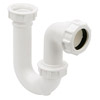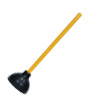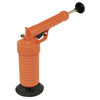Clearing Blocked Pipes & Drains
Introduction
Internal waste pipes can easily become blocked over time with hair, grease, kitchen waste, etc. Putting off clearing them isn't a particularly good idea as over time not only will the water will cease to flow, but the smells from the drain and the rotting materials will become noticable inside the property.
In a two pipe drainage system external gullies, stacks and drains can easily become blocked, especially in winter where falling leaves invariably find there way into the drains. If the drains become so blocked that the water ceases to flow, then this can easily lead to damp forming on the outside walls of the property.
Clearing u-bend traps
Situated below the plug hole of all washbasins, sinks and baths, the u-bend trap is filled with water at all times to primarily prevent drain smells from escaping inside the property. If objects of any size or weight manage to fall between the gaps of the plug hole, then invariably they will sit at the bottom of the trap rather than making their way down the waste pipes to the sewers.
The simplest way to clear a blocked u-bend or to retrieve a lost item, is to place a bucket under the u-bend and to unscrew the retaining caps using a wrench. Let the trap fall into the bucket first, then empty the water and fish around inside using a length of wire.
If clearing a blockage, then it is also advisable to clear the immediate section of waste pipe too, or as much as you can reach, using the length of wire to ensure that there is not another blockage a little further down.

Clearing a u-bend trap
- To remove, unscrew the fittings and place in a bucket.
- If the fittings are stiff use a wrench to free them.
- Before reconnecting, flush the bend out with a little detergent to ensure any bacteria is removed.

Clearing a bottle trap
- This type of trap is easier to clear as the base cap can be removed to gain access to the pipe.
- If the fittings are stiff use a wrench to free them.
- Before reconnecting, clean the cap and trap pipe with a little detergent to ensure any bacteria is removed.
Clearing the waste pipe
If a washbasin, sink or bath fails to drain properly, and the u-bend trap has been checked and has found to not be at fault, then it is highly likely that a blockage has formed at some point along the waste pipework. The best place to start is to use a chemical drain cleaner, following the manufacturers instructions allow it plenty of time to tackle the blockage.
If a chemical cleaner fails to do the job then try a sink plunger. To plunge a sink:

- If using a traditional sink plunger, first smear some grease (vaseline works fine) onto the underside of the rubber cup
- Firmly hold the plunger over the plug hole, then fill the washbasin, sink or bath with approximately 127mm (5in) of water or enough to cover the rubber cup
- Place a wet cloth into the overflow outlet
- Pump the plunger up and down a few times until water runs smoothly and cleanly from the appliance

- If using a power sink plunger, first choose the correct size of rubber adaptor to fit the plug hole you are dealing with
- Place the power plunger against a hard surface and pump the plunger a few times to ensure that the internal valve sits firmly in place
- Pump the plunger a further 1-4 times to increase the power (air pressure). If using plastic plumbing 3 times should be adequate
- Place a wet cloth over/into the overflow outlet
- Place the plunger firmly over the plug hole, and if necessary (ie the sink is empty) fill the washbasin, sink or bath with approximately 127mm (5in) of water or enough to cover the rubber adaptor
- Release the pressurised air into the waste pipe to clear the blockage
Clearing a blocked gully or hopper
If you notice the gully or hopper overflowing when, for example, the bath is drained, then there is a high probability that the gully is blocked with leaves and/or other items of flora.
To unblock, take off the grill and using a gloved hand remove all of the debris. Clear the bottom of the gully pipe with a length of wire, and pour some disinfectant down the hopper pipe and the gully pipe to remove any bacteria and prevent smells finding their way inside the property.
If the flooded gully appears to be clear of debris but still continues to flood, then try locating the blockage at the nearest inspection chamber.
Using a high pressure water hose along the pipework away from the property can also be an effective way of forcing loose a blockage.
Unblocking soil pipes & WC pans
A blocked toilet can often be cleared by using a large plunger, known as a cooper's plunger. Lower the plunger into the wc pan and ensure the ruber cup is firmly into the u-bend. Pump the handle of the plunger until the blockage is removed - this will become apparent as the water level will drop quite noticably.
If a plunger fails to remove the blockage then it is highly likely that the soil pipe is blocked. To unblock this is a particularly unpleasant task, especially if the drainage system is made from cast iron, as the rodding equipment needed to remove the blockage will need to be inserted at the roof vent.
- Unless you are feeling particularly brave, it is highly advisable under these circumstances to consult a professional plumber or a professional drain clearing company.
Further information and useful links
- Find a Plumber near you
- Find a Drainage Specialist near you
Site Pages
Featured Articles





